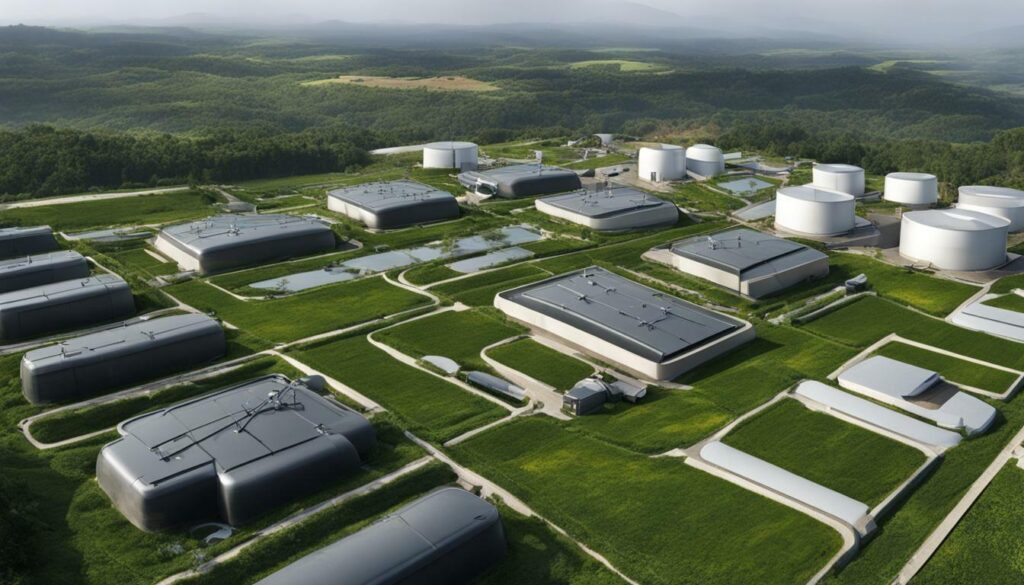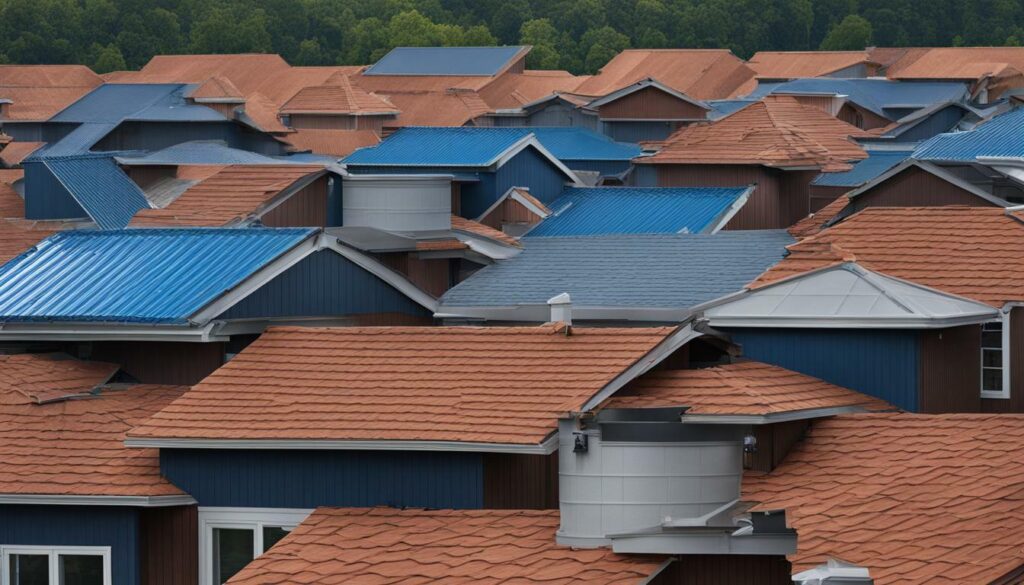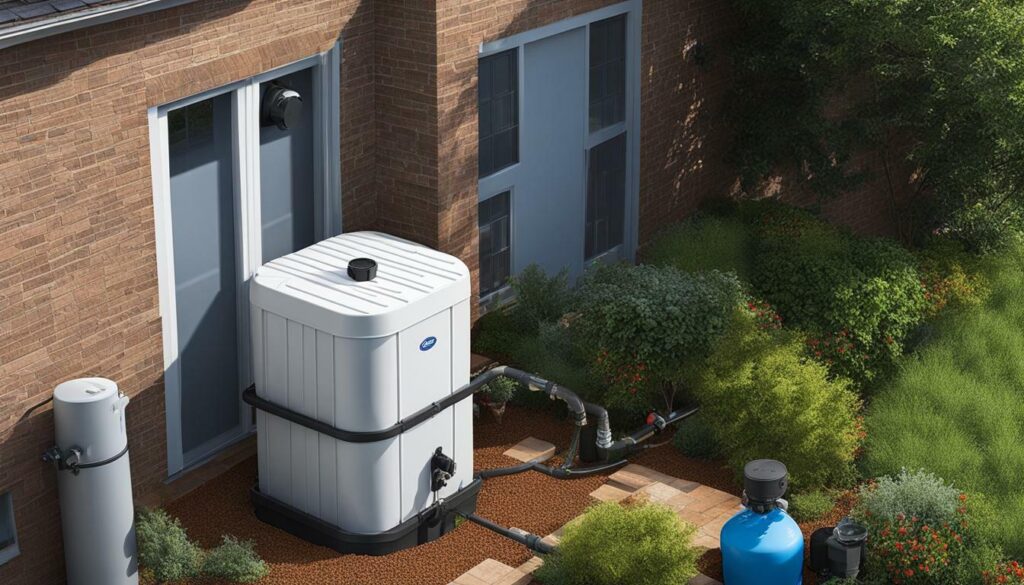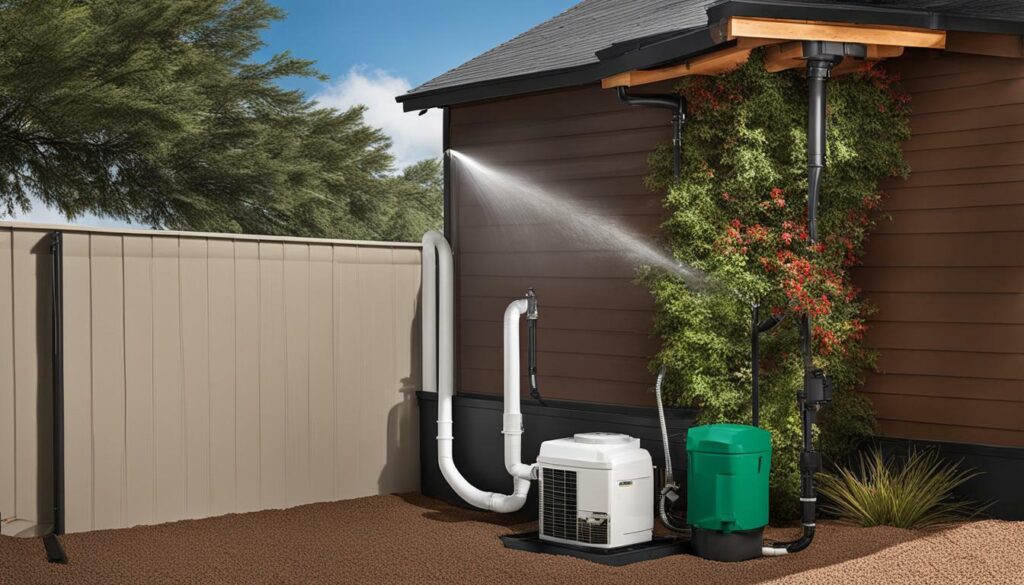Maximize Your Rainwater Harvesting with Roofs in the US
Rainwater harvesting with roofs is an effective and sustainable method to supplement water sources or meet water needs in the United States. With the abundance of rainfall in many regions of the country, utilizing rooftops for rainwater collection presents an opportunity to conserve water resources and reduce dependence on traditional water supplies. By harnessing the power of mother nature, homeowners and businesses can contribute to a more sustainable future.
Roofs are an ideal platform for rainwater harvesting due to their large surface areas and existing features like gutters and downspouts. The size of the roof directly affects the amount of rainwater that can be collected, making it important to maximize the potential of this valuable resource. Choosing quality roof materials, such as polymer-coated roofs or asphalt shingles with sealant, ensures optimal water collection and minimizes contamination.
Roof pitch also plays a crucial role in rainwater harvesting. Low-angle roofs are more efficient in preventing water loss, while high-angle roofs provide better cleanliness by allowing water to flow more freely and wash away any accumulated debris. Properly designed gutters, downspouts, and pipes help channel rainwater from the roof to a storage container, ensuring efficient collection and utilization.
Key Takeaways:
- Rainwater harvesting with roofs is an effective and sustainable method to supplement water sources in the US.
- Choosing quality roof materials and maintaining a suitable roof pitch maximizes water collection and minimizes contamination.
- Gutters, downspouts, and pipes are essential for channeling rainwater from the roof to a storage container efficiently.
- Using pre-tank filters, additional filtration, and treatment helps maintain water quality in rainwater harvesting systems.
- Regular maintenance is necessary for rainwater harvesting systems to ensure optimal functionality and cleanliness.
Understanding Rainwater Harvesting and its Benefits
Rainwater harvesting is the practice of collecting rainfall to supplement water sources and offers numerous benefits, making it an environmentally friendly choice. By utilizing rainwater, you can reduce your dependence on traditional water sources and decrease the strain on local water supplies. This sustainable approach not only helps conserve water but also promotes self-sufficiency and reduces utility costs. In addition, rainwater is naturally soft, making it ideal for various household and outdoor uses.
There are several methods of rainwater harvesting that can be implemented based on the available resources and requirements. Some common methods include direct catchment, where rainwater is collected from rooftops and funneled into storage containers, and surface runoff harvesting, where rainwater is captured from land surfaces and directed into storage systems. Each method has its own advantages and can be tailored to meet specific needs.
| Benefits of Rainwater Harvesting: |
|---|
| • Conservation of water resources |
| • Cost savings on water bills |
| • Reduced strain on local water supplies |
| • Independence from municipal water sources |
| • Soft water suitable for various household uses |
| • Mitigation of stormwater runoff |
When considering rainwater harvesting, it is essential to evaluate the benefits and suitability for your specific needs. Assessing factors like rainfall patterns, available roof space, and local regulations will help determine the feasibility and potential impact of implementing a rainwater harvesting system.
Utilizing Roofs for Rainwater Harvesting
Roofs are ideal for rainwater harvesting due to their large surface areas and existing features like gutters and downspouts, making them a crucial component of a rainwater harvesting system. By collecting rainwater from the roof, you can effectively channel it to a storage container for future use. This sustainable practice helps reduce reliance on traditional water sources and promotes environmental conservation.
When it comes to rooftop rainwater harvesting, the design and materials of the roof play a significant role in maximizing water collection. Choosing quality roof materials is essential to ensure durability and prevent any potential contaminants from entering the harvested water. Consider options such as polymer-coated roofs or asphalt shingles with sealant, which are suitable for rainwater harvesting and offer long-lasting performance.
The roof pitch, or the angle at which the roof slopes, also affects rainwater harvesting. Low angle roofs are more effective in preventing water loss during heavy rainfall, ensuring maximum water capture. On the other hand, high angle roofs provide better cleanliness, as they allow dirt and debris to wash off easily. It is important to consider the roof pitch when designing a rainwater harvesting system to optimize its efficiency.

To effectively channel rainwater from the roof, gutters, downspouts, and pipes are utilized. The gutters collect the rainwater and direct it towards the downspouts, which then channel the water to the storage container. It is crucial to maintain these components regularly to ensure the smooth flow of rainwater and prevent any blockages.
Overall, rooftop rainwater harvesting offers a sustainable water solution and can significantly contribute to water conservation efforts. By utilizing roofs to collect rainwater, you can reduce water waste and reliance on conventional water sources. With proper design, materials, and maintenance, rainwater harvesting systems can provide a reliable and eco-friendly water supply for various purposes.
Choosing the Right Roof Materials for Rainwater Harvesting
To optimize rainwater harvesting, it is essential to select quality roof materials that are compatible with water collection systems, such as polymer-coated roofs or asphalt shingles with sealant. These materials play a crucial role in the effectiveness and efficiency of rainwater collection, ensuring that the harvested water is clean and safe for use.
Polymer-coated roofs are an excellent choice for rainwater harvesting due to their durability and resistance to corrosion. The polymer coating acts as a protective layer, preventing contaminants from leaching into the collected water. In addition, the smooth surface of polymer-coated roofs allows rainwater to flow more easily into gutters, minimizing water loss.
Another suitable option is asphalt shingles with sealant. These shingles are designed to provide superior waterproofing, preventing any water leakage or seepage. The sealant applied to the shingles enhances their durability and ensures a secure barrier against moisture. When combined with proper gutter and downspout systems, asphalt shingles with sealant can effectively channel rainwater to storage tanks.
When selecting roof materials for rainwater harvesting, it is crucial to consider their compatibility with the chosen water collection system. The roofing material should be able to withstand the weight and pressure of the collected rainwater and should not interact with the water in a way that compromises its quality. Choosing the right roof materials is a significant step towards maximizing the potential of rainwater harvesting systems and promoting sustainable water management.

| Roof Material | Benefits |
|---|---|
| Polymer-Coated Roofs | Durable, resistant to corrosion, smooth surface for better water flow |
| Asphalt Shingles with Sealant | Superior waterproofing, secure barrier against moisture |
Considerations for Roof Pitch in Rainwater Harvesting
The pitch of your roof plays a crucial role in rainwater harvesting, with low angle roofs preventing water loss and high angle roofs providing better cleanliness by allowing debris to slide off. When it comes to maximizing rainwater collection, understanding the impact of roof pitch is key. Here are some considerations to keep in mind:
- A low angle roof, typically ranging from 2 to 12 degrees, allows rainwater to flow more slowly, minimizing the chances of water splashing or bouncing off the surface. This helps prevent water loss during heavy rainfall.
- On the other hand, high angle roofs with pitches greater than 12 degrees facilitate the natural self-cleaning process. As rainwater flows down the roof, it carries leaves, twigs, and other debris away, keeping the harvested water cleaner.
It’s essential to find the right balance between preventing water loss and maintaining water cleanliness. You can consult with a roofing professional to determine the optimal roof pitch for your rainwater harvesting system based on your specific needs and local climate conditions.
Table: Recommended Roof Pitches for Rainwater Harvesting
| Roof Pitch | Water Loss Prevention | Cleaning Efficiency |
|---|---|---|
| Low Angle (2-12 degrees) | High | Low |
| Medium Angle (12-30 degrees) | Moderate | Moderate |
| High Angle (above 30 degrees) | Low | High |
Remember that the roof pitch is just one factor to consider when setting up a rainwater harvesting system. Proper gutter installation, downspout positioning, and regular maintenance are also critical for optimal performance. With the right roof pitch and a well-designed rainwater collection system, you can maximize your water harvesting efforts and contribute to a more sustainable future.

Gutters, downspouts, and pipes are essential components of a rainwater harvesting system, facilitating the efficient collection and transportation of rainwater from the roof to a storage container. Gutters are installed along the edges of the roof, helping to capture rainwater as it flows down from the surface. They are typically made of durable materials such as aluminum or PVC, ensuring longevity and resistance to weather conditions. Downspouts, also known as downpipes, are attached to the gutters, guiding the collected rainwater downwards. These vertical pipes are available in different sizes and can be made of various materials, such as metal or plastic, to suit the specific needs of the system.
To further optimize the rainwater collection process, the use of pipes is crucial. These pipes connect the downspouts to the storage container, allowing rainwater to flow smoothly from the roof to its final destination. High-quality PVC or HDPE pipes are commonly used due to their durability and resistance to corrosion. The size of the pipes should be selected based on the expected volume of rainwater to be harvested and the distance it needs to be transported.

Table 1: Comparison of Gutter Materials
| Gutter Material | Advantages | Disadvantages |
|---|---|---|
| Aluminum | – Lightweight – Resistant to rust – Long lifespan |
– Higher cost compared to other materials |
| PVC | – Lightweight – Easy to install – Cost-effective |
– Prone to expansion and contraction with temperature changes |
| Galvanized Steel | – Sturdy and durable – Suitable for heavy rainfall – Resistant to impact |
– Susceptible to rust over time |
Table 1 provides a comparison of common gutter materials used in rainwater harvesting systems. It can help homeowners and professionals make informed decisions when selecting the most suitable gutter material based on their specific requirements.
Maintaining Water Quality in Rainwater Harvesting Systems
While pre-tank filters can remove debris from collected rainwater, it is crucial to acknowledge that microscopic contaminants may still pass through, necessitating further filtration or treatment to ensure water quality. To address this concern, additional filtration methods should be implemented as part of rainwater harvesting systems.
One effective way to enhance water quality is by incorporating a multi-stage filtration system. This involves using multiple filters with varying degrees of filtration to remove contaminants of different sizes. For example, sediment filters can remove larger particles, while activated carbon filters can effectively capture organic compounds and chemicals.
Furthermore, it is important to consider the use of treatment systems to eliminate any remaining contaminants. Ultraviolet (UV) disinfection is a common treatment method, as it uses UV light to destroy harmful microorganisms in the water. Additionally, chemical disinfection methods, such as chlorination or ozonation, can be employed to ensure water safety.
| Additional Filtration Methods | Treatment Systems |
|---|---|
| Multi-stage filtration system | Ultraviolet (UV) disinfection |
| Sediment filters | Chemical disinfection |
| Activated carbon filters |
By incorporating these additional filtration and treatment methods, homeowners and property owners can ensure that the rainwater harvested from their rooftops is of optimal quality and safe for various applications, such as irrigation, toilet flushing, or laundry. Regular maintenance and monitoring of these filtration and treatment systems are also essential to ensure continued effectiveness and performance.

- Pre-tank filters remove debris from collected rainwater but may not eliminate microscopic contaminants.
- Additional filtration methods, such as multi-stage filtration systems and activated carbon filters, should be incorporated to enhance water quality.
- Treatment systems, including UV disinfection and chemical disinfection, can be used to eliminate remaining contaminants.
- Regular maintenance and monitoring are essential for the optimal performance of filtration and treatment systems.
Enhancing Water Quality with First Flush Diverters
First flush diverters are an effective solution for improving water quality in rainwater harvesting systems, as they discard the initial dirty rainfall that may contain more pollutants. These devices are installed at the beginning of the rainwater collection system and work by diverting the first flush of rainwater away from the storage tank.
The concept behind first flush diverters is simple yet highly beneficial. When it rains, the first flush of water that collects on the roof typically contains debris, dirt, and pollutants that have accumulated over time. By diverting this initial runoff away from the storage tank, first flush diverters prevent these contaminants from entering the system and potentially compromising the quality of the harvested rainwater.
“First flush diverters are an essential component of rainwater harvesting systems, ensuring that only clean and filtered rainwater is stored for various non-potable uses.”
The diverted initial dirty rainfall can be directed to a separate drainage system or even to a garden bed, where the contaminants can be naturally filtered and absorbed by the soil. This process not only improves the water quality but also reduces the need for additional filtration or treatment, making rainwater harvesting systems more efficient and sustainable.
Enhancing Water Quality with First Flush Diverters
- Discards initial dirty rainfall
- Prevents pollutants from entering the storage tank
- Reduces the need for additional filtration or treatment
By incorporating first flush diverters into rainwater harvesting systems, property owners can maximize the quality and usability of their harvested rainwater. With improved water quality, the collected rainwater becomes ideal for various non-potable uses, such as irrigation, toilet flushing, and outdoor cleaning, contributing to water conservation efforts and reducing reliance on conventional water sources.

Note: The image above illustrates the concept of first flush diverters in rainwater harvesting systems.
| Advantages of First Flush Diverters |
|---|
| 1. Improves water quality |
| 2. Prevents pollutants from entering the storage tank |
| 3. Reduces the need for additional filtration or treatment |
Rainwater Storage Tanks for Harvested Water
Rainwater storage tanks are vital for storing harvested water and should be sized appropriately based on the catchment area and water demand to ensure an adequate supply. The size of the storage tank will depend on the roof size and the amount of rainfall received. It is important to consider the average annual rainfall in your area and the size of your roof when determining the storage tank capacity.
When choosing a storage tank, there are various options available, including plastic and metal tanks. Plastic tanks are lightweight, durable, and often more affordable, making them a popular choice for rainwater harvesting systems. Metal tanks, such as stainless steel or galvanized tanks, offer increased durability and can withstand harsh weather conditions.

Additionally, it is crucial to consider the water demand of your property. Factors such as the number of occupants, the intended use of the harvested water, and the availability of alternative water sources should be taken into account. This will ensure that the storage tank is sized adequately to meet your water needs.
Regular maintenance of the storage tank is essential to ensure its longevity and the quality of the harvested water. It is recommended to inspect the tank regularly for any leaks or damage. Cleaning the tank periodically and removing any sediment or debris will help maintain water quality and prevent contamination.
In summary, rainwater storage tanks are an integral part of rainwater harvesting systems. Sizing the storage tank correctly based on the catchment area and water demand is crucial for ensuring a sufficient supply of harvested water. By choosing the right material, regular maintenance, and proper cleaning, you can maximize the effectiveness and longevity of your rainwater storage tank.
Regular Maintenance of Rainwater Harvesting Systems
Regular maintenance is crucial for the proper functioning of rainwater harvesting systems, which involves cleaning the collection system, filters, and storage tank to ensure optimal performance. By following a regular maintenance routine, you can prolong the lifespan of your system and ensure the quality of the harvested water.
One of the key maintenance tasks is cleaning the collection system, which includes gutters, downspouts, and pipes. Over time, debris such as leaves, twigs, and bird nests can accumulate, obstructing the flow of rainwater. Regularly inspect and clean these components to prevent blockages and ensure a smooth flow of water from the roof to the storage tank.
Filters are another critical component that require regular cleaning. Pre-tank filters help remove larger debris, but microscopic contaminants may still pass through. It is recommended to check and clean the filters periodically to prevent clogging and maintain water quality. Additionally, consider installing additional filtration systems or treatment methods to remove any remaining impurities.
The storage tank should also be inspected and cleaned regularly. Sediment, algae, and other contaminants can accumulate over time, affecting water quality and potentially damaging the tank. Drain the tank periodically and thoroughly clean the interior to ensure the stored water remains fresh and free from pollutants. Regular maintenance of the storage tank also includes checking for any signs of leaks or damage that may require repairs.
Conclusion
Rainwater harvesting with roofs offers significant benefits, making it a sustainable solution for supplementing water sources and meeting water needs in the US. By utilizing roofs and implementing proper techniques, individuals can make a positive impact on water conservation and sustainability.
Roofs, with their large surface areas and existing features like gutters and downspouts, are ideal for collecting rainwater. The size of the roof directly affects the amount of rainwater that can be harvested, making it crucial to consider the roof’s dimensions when designing a rainwater harvesting system.
Choosing quality roof materials, such as polymer-coated roofs or asphalt shingles with sealant, is essential for effective rainwater harvesting. These materials help ensure the collected water remains clean and uncontaminated. Additionally, considering the roof pitch is important, as low angle roofs prevent water loss, while high angle roofs result in better water cleanliness.
Properly channeling rainwater from the roof to a storage container is crucial for a successful rainwater harvesting system. Gutters, downspouts, and pipes play a vital role in this process, ensuring that the collected rainwater is effectively transported and stored.
To maintain water quality in rainwater harvesting systems, pre-tank filters can be used to remove debris. However, it is important to note that microscopic contaminants may still pass through, necessitating additional filtration or treatment to ensure the water is safe for use.
First flush diverters are a valuable tool for improving water quality in rainwater harvesting systems. These diverters discard the initial dirty rainfall, ensuring that only clean water is collected and stored.
Choosing the right rainwater storage tank is also crucial. These tanks can be made from plastic or metal and should be sized based on the catchment area and water demand of the property. Regular maintenance, including cleaning the collection system, filters, and storage tank, is necessary to ensure the system operates at its best.
Overall, rainwater harvesting with roofs is a practical and sustainable solution that offers numerous benefits. By implementing the right techniques and taking necessary precautions, individuals can make a positive impact on water conservation and sustainability, ensuring a more environmentally friendly future.
FAQ
Q: What is rainwater harvesting?
A: Rainwater harvesting is the practice of collecting rainfall to supplement water sources or meet a property’s water needs.
Q: Why are roofs commonly used for rainwater harvesting?
A: Roofs are commonly used for rainwater harvesting due to their large surface areas and existing features like gutters and downspouts.
Q: How does the size of the roof affect rainwater harvesting?
A: The size of the roof directly affects the amount of rainwater that can be harvested.
Q: What kind of roof materials are recommended for rainwater harvesting?
A: It is recommended to choose quality roof materials, such as polymer-coated roofs or asphalt shingles with sealant, for rainwater harvesting.
Q: What role does roof pitch play in rainwater harvesting?
A: The roof pitch plays a role in rainwater harvesting, with low angle roofs being best for preventing water loss and high angle roofs providing better cleanliness.
Q: How can rainwater be channeled from the roof to a storage container?
A: Gutters, downspouts, and pipes are used to channel rainwater from the roof to a storage container.
Q: How can water quality be maintained in rainwater harvesting systems?
A: Pre-tank filters can be used to remove debris, but microscopic contaminants may still pass through, requiring additional filtration or treatment.
Q: What are first flush diverters and how do they improve water quality?
A: First flush diverters discard the initial dirty rainfall to improve water quality in rainwater harvesting systems.
Q: What type of storage tanks are used for harvested rainwater?
A: Rainwater storage tanks can be made from plastic or metal and should be sized based on the catchment area and water demand.
Q: How important is regular maintenance for rainwater harvesting systems?
A: Regular maintenance, including cleaning the collection system, filters, and storage tank, is necessary for rainwater harvesting systems.






